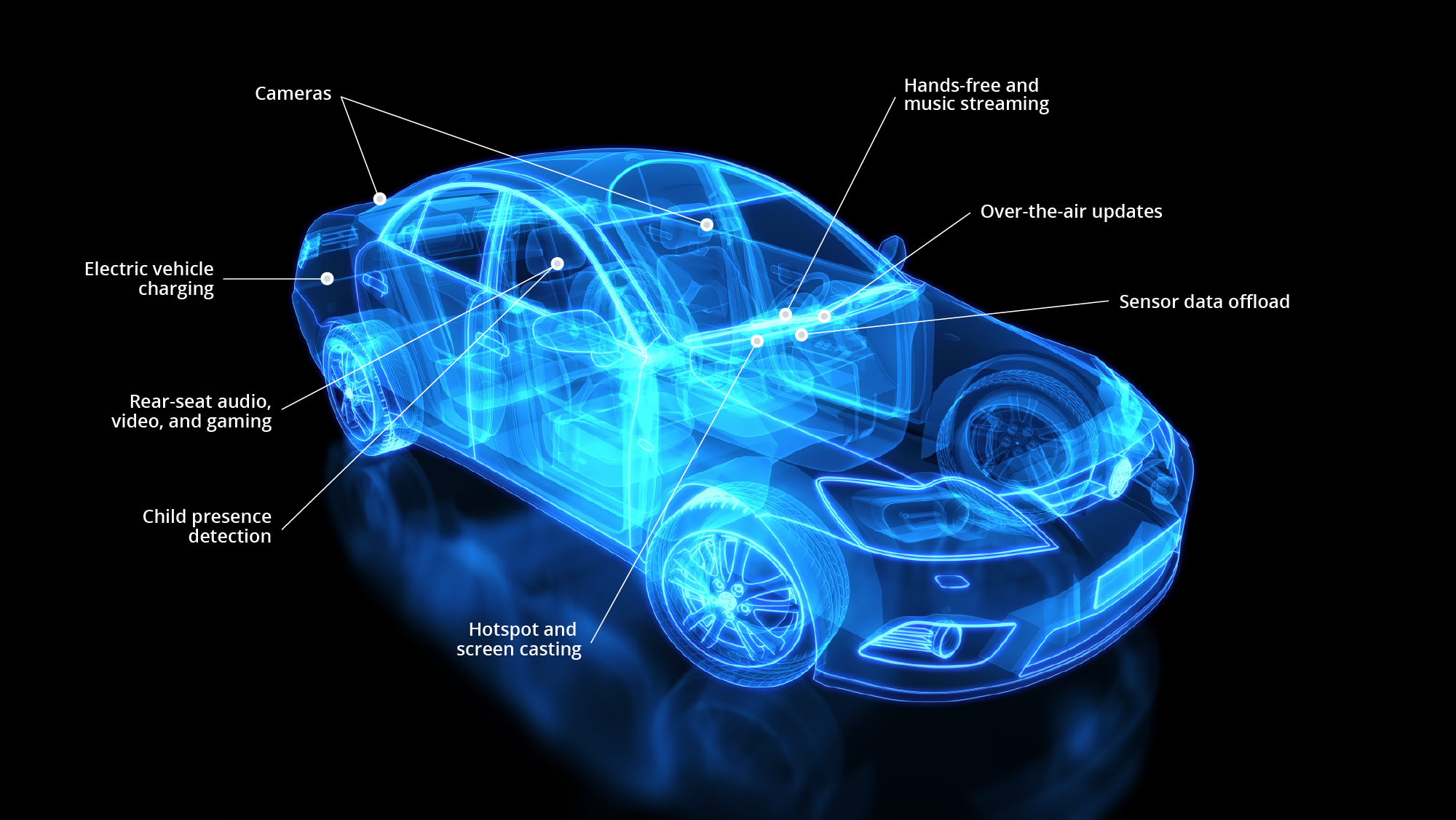Wi-Fi® and the connected vehicle
Wireless connectivity in vehicles began over a decade ago, but recent years have seen a dramatic increase in Wi-Fi® in automotive. According to McKinsey, by 2030 about 95 percent of new vehicles sold globally will be connected. Customers now expect their connectivity experience in a vehicle to reflect that of their home or office, including streaming music and videos, providing in-car hotspots for devices, and casting a smartphone onto the in-dash display.
While Wi-Fi in vehicles has primarily focused on infotainment, new use cases have started to go mainstream, including wireless sensor data collection, over-the-air firmware and map updates, data exchange with electric-vehicle charging stations, and opportunistic data upload and download leveraging network connectivity, for instance, in parking lots and gas and electric vehicle charging stations. For automakers, chipset suppliers, and module vendors that want to accelerate digital transformation and provide exceptional in-vehicle connectivity, Wi-Fi is the best solution because it is widely adopted by consumers, offers inexpensive data offload, and supports low latency applications with the latest Wi-Fi generations.
Vehicle transformation drives new Wi-Fi use cases
Wi-Fi enables many connected vehicle use cases and services that improve safety and vehicle design, and extend the consumer connectivity experience:
- In-vehicle infotainment systems
- In-vehicle Wi-Fi hotspots
- Over-the-air software updates
- Map updates
- Sharing vehicle diagnostics
- Fixed electric vehicle charging stations
- Other
In-vehicle infotainment (IVI) systems
The functionality of IVI systems is expanding. While they have traditionally played audio content, made phone calls, and allowed access to the Internet and mobile phone-enabled content through casting, they could also render 2D and 3D models of the environment around the vehicle, display backup and side cameras, stream movies and games to front- or rear-seat displays, allow access to social media, and offer more back-seat entertainment.
In-vehicle Wi-Fi hotspots
A Wi-Fi hotspot within a vehicle enables passengers to enhance their riding experience by enjoying various applications including streaming, gaming, and web browsing on the vehicle’s infotainment displays and personal devices. Vehicles can also connect to a hotspot provided by a smartphone, allowing the vehicle to offer these connected services.
Over-the-air software updates
Connected vehicles can receive new software features and fixes while parked at home, garages, parking lots, gas stations, electric vehicle charging stations, or coffee shops. This saves time-consuming trips to the dealership. Due to its high data rate and secure links, Wi-Fi makes over-the-air updates both fast and cost-effective by avoiding cellular data charges.
Map updates
With Wi-Fi, vehicle navigation systems can receive map updates while parked or even on the road with a steady enough Wi-Fi link. These updates often require large data downloads, which are accelerated by Wi-Fi’s high-throughput links.
Sharing vehicle diagnostics
Vehicles with Wi-Fi can utilize fast, cost-effective connectivity to transmit diagnostic information from onboard sensors, cameras, and other monitoring systems, promoting proactive maintenance and enhanced safety. This diagnostic information enables quick evaluation, remote troubleshooting, and efficient service delivery to maximize vehicle uptime and performance.
Fixed electric vehicle charging stations
Fixed chargers, also known as charging stations, are stationary infrastructure for electric vehicles (EVs). Placed in public areas, highways, malls, and offices, they allow EV owners to charge their vehicles while on the move. Both consumers and vehicles can benefit from Wi-Fi connectivity when using a fixed charging station by using the Wi-Fi network to do work or for the vehicle to upload/offload data.
Other
Other Wi-Fi based applications are currently under consideration for automotive use. These include child presence detection (CPD) via Wi-Fi sensing and vehicle access via Wi-Fi proximity ranging.

Wi-Fi CERTIFIED® optimizes automotive connectivity
Wi-Fi CERTIFIED® provides companies in the automotive industry a path to securing fast, reliable Wi-Fi connectivity in modern vehicles.
Performance: Wi-Fi CERTIFIED 6® and Wi-Fi CERTIFIED 7™ support vehicles by offering the latest Wi-Fi capabilities, including 6 GHz operation, high throughput, robust connections, deterministic latency, and reduced power consumption. With the aid of defined Wi-Fi data elements, Wi-Fi performance metrics can be continuously collected and monitored to provide a high-quality consumer experience under changing vehicular settings and environmental conditions. For more detail on how Wi-Fi 7 drives outstanding vehicle connectivity, read this blog.
Security: Wi-Fi also offers vehicles and consumer devices the highest level of security with the WPA3™ certification. WPA3-Personal provides the latest authentication for password-based networks to protect wireless traffic from password guessing attempts, and WPA3-Enterprise provides top-of-the-line security for guest, public, and other credential-based networks. Wi-Fi CERTIFIED Enhanced Open™ provides encryption for unauthenticated hotspots.
Efficiency: Wi-Fi CERTIFIED QoS Management™ offers passengers access to applications that require low latency, such as video streaming, and Wi-Fi CERTIFIED Optimized Connectivity™ reduces the time-to-first-byte.


